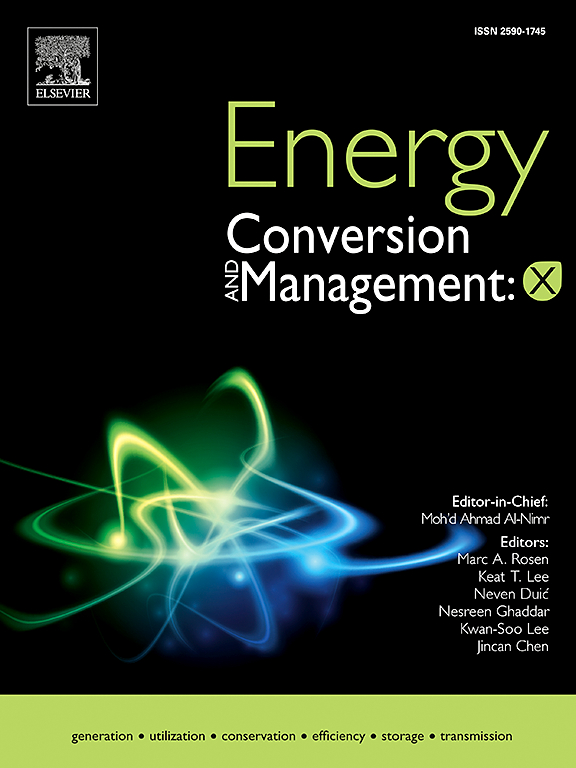Pyro-gasification of Norwegian industrial solid waste (ISW) for hydrogen production and district heating application: A 4-E (energy, exergy, environment, and economic) analysis
IF 7.6
Q1 ENERGY & FUELS
引用次数: 0
Abstract
Electricity or heat production from waste incineration is often inefficient and costly, posing challenges for Norway’s ambition to achieve net-zero carbon emissions and a hydrogen-based economy by 2050. To address these challenges, this study aims to develop and evaluate two advanced thermochemical pathways- Sorption-Enhanced Chemical Looping Gasification (SE-CLG) and Pyrolysis-Integrated SE-CLG (Pyro-SE-CLG) for tri-generation (hydrogen, heat, and electricity) from Norwegian Municipal Solid Waste (MSW) and Industrial Solid Waste (ISW), while improving waste management efficiency and environmental performance. Experimental characterization of typical Norwegian ISW (HHV = 17.43 MJ/kg; LHV = 16.22 MJ/kg) revealed substantial energy potential. From literature, heavy metal presence in this type of waste and oxygen carrier (OC) deactivation with ash interaction prompted the development of the Pyro-SE-CLG model to enhance feedstock flexibility, facilitate heavy metal removal, and align waste utilization with national decarbonization goals. Both models were simulated using Aspen Plus and assessed via a 4-E (Energy, Exergy, Environment, and Economic) analysis. The SE-CLG maximized hydrogen yield at (170.6 kg H2/ton MSW; 142.8 kg H2/ton ISW), energy efficiency (up to 69.11 %), exergy efficiency (up to 57.29 %), and hot water recovery (up to 4,300 L/ton MSW) for district heating applications. Pyro-SE-CLG, while yielding 16–20 % less hydrogen and requiring five times more oxygen carrier (OC), enabled complete heavy metal removal using 200 kg of 1 M HCl per ton ISW and improved OC reusability, thereby reducing operational costs. Sensitivity analysis identified optimal hydrogen production at 800 °C (fuel reactor) and 200 °C (WGSR), with Ca2Fe2O5 ensuring stable performance across both configurations. Environmental analysis highlighted SE-CLG(MSW) as the most favorable option, achieving 25.55 % lower global warming potential (GWP) and 66.80 % lower acidification potential (AP) than ISW, while Pyro-SE-CLG reduced GWP during pyrolysis but exhibited higher post-PSA emissions due to lower CO2 capture efficiency. Economically, Pyro-SE-CLG(ISW) achieved the lowest hydrogen sale price (3.32 USD/kg), whereas SE-CLG(ISW) recorded the highest sustainability index (SI = 2.34). By optimizing hydrogen and heat recovery while addressing heavy metal contamination, this study supports Norway’s transition toward a circular, low-carbon energy system and demonstrates the potential of waste-to-hydrogen pathways to meet national 2050 sustainability targets.

挪威工业固体废物(ISW)的热解气化制氢和区域供热应用:一个4-E(能源,能源,环境和经济)分析
垃圾焚烧发电或供热往往效率低下且成本高昂,这对挪威到2050年实现净零碳排放和氢基经济的雄心构成了挑战。为了应对这些挑战,本研究旨在开发和评估两种先进的热化学途径-吸附-增强化学循环气化(SE-CLG)和热解-集成SE-CLG (pyrose - clg),用于从挪威城市固体废物(MSW)和工业固体废物(ISW)中三联产(氢、热、电),同时提高废物管理效率和环境绩效。挪威典型ISW (HHV = 17.43 MJ/kg)的实验表征;LHV = 16.22 MJ/kg)显示出巨大的能量潜力。从文献来看,这类废物中重金属的存在以及氧载体(OC)与灰分相互作用的失活促使了pore - se - clg模型的发展,以增强原料的灵活性,促进重金属的去除,并使废物利用与国家脱碳目标保持一致。两种模型都使用Aspen Plus进行了模拟,并通过4-E(能源、能源、环境和经济)分析进行了评估。SE-CLG在170.6 kg H2/t MSW时产氢量最大;142.8 kg H2/吨ISW),能源效率(高达69.9%),火用效率(高达57.29%)和热水回收(高达4300升/吨MSW)用于区域供热应用。pore - se - clg的氢气产出量减少了16 - 20%,氧载体(OC)的需氧量增加了5倍,每吨ISW使用200千克1 M HCl即可完全去除重金属,并提高了OC的可重用性,从而降低了运营成本。灵敏度分析确定了800°C(燃料反应堆)和200°C (WGSR)下的最佳产氢量,Ca2Fe2O5确保了两种配置下的稳定性能。环境分析显示,SE-CLG(MSW)是最有利的选择,与ISW相比,SE-CLG的全球变暖潜能值(GWP)降低了25.55%,酸化潜能值(AP)降低了66.80%,而pro -SE-CLG在热解过程中降低了GWP,但由于CO2捕获效率较低,psa后排放较高。从经济角度来看,pro -SE-CLG(ISW)实现了最低的氢气销售价格(3.32美元/公斤),而SE-CLG(ISW)的可持续性指数最高(SI = 2.34)。通过优化氢和热回收,同时解决重金属污染问题,本研究支持挪威向循环低碳能源系统过渡,并展示了废物制氢途径实现2050年国家可持续发展目标的潜力。
本文章由计算机程序翻译,如有差异,请以英文原文为准。
求助全文
约1分钟内获得全文
求助全文
来源期刊

Energy Conversion and Management-X
Multiple-
CiteScore
8.80
自引率
3.20%
发文量
180
审稿时长
58 days
期刊介绍:
Energy Conversion and Management: X is the open access extension of the reputable journal Energy Conversion and Management, serving as a platform for interdisciplinary research on a wide array of critical energy subjects. The journal is dedicated to publishing original contributions and in-depth technical review articles that present groundbreaking research on topics spanning energy generation, utilization, conversion, storage, transmission, conservation, management, and sustainability.
The scope of Energy Conversion and Management: X encompasses various forms of energy, including mechanical, thermal, nuclear, chemical, electromagnetic, magnetic, and electric energy. It addresses all known energy resources, highlighting both conventional sources like fossil fuels and nuclear power, as well as renewable resources such as solar, biomass, hydro, wind, geothermal, and ocean energy.
 求助内容:
求助内容: 应助结果提醒方式:
应助结果提醒方式:


